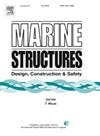基于范德波尔唤醒振荡器模型的深水钻井隔水管涡流诱导振动数值分析
IF 4
2区 工程技术
Q1 ENGINEERING, CIVIL
引用次数: 0
摘要
采用中心有限差分法求解了深水钻井隔水管动态模型和范德波尔唤醒振荡器模型的耦合方程。计算了立管的涡流诱导振动(VIV)响应和疲劳寿命,并通过与已公布的实验和模拟结果进行对比,对模型进行了验证。讨论了顶部张力、水流速度、流速剖面、内部流速以及浮力模块的安装对 VIV 的影响。初步分析了立管在直列(IL)和横流(CF)VIV 条件下的动态响应和疲劳寿命。结果表明,立管的 VIV 具有多种模式,并表现出驻波和行波的混合行为。随着顶部张力和流速剖面系数的增加,VIV 主导模态的阶数和 VIV 位移均方根(RMS)的峰值降低,立管的疲劳寿命延长。随着流速的增加,VIV 主模的阶数增加,立管的疲劳寿命缩短。内部流速对立管 VIV 的影响可以忽略。安装浮力模块可以改善立管应力状态,延长疲劳寿命。与 CF VIV 模型相比,在 IL 和 CF 耦合 VIV 模型下,由于弯矩的减小和疲劳弱点位置的改变,计算出的立管最小疲劳寿命延长了。本文章由计算机程序翻译,如有差异,请以英文原文为准。
Numerical analysis of vortex-induced vibration of deepwater drilling riser based on Van der Pol wake oscillator model
Coupled equations of the dynamic model and the Van der Pol wake oscillator model are solved by the central finite difference method for the deepwater drilling riser. The vortex-induced vibration (VIV) response and fatigue life of the riser are calculated and the model validation is performed by comparing with the published experimental and simulation results. The effects of the top tension, current flow velocity, flow velocity profile, internal flow velocity as well as the installation of buoyancy modules on the VIV are discussed. Dynamic response and fatigue life of the riser under In-Line (IL) and Cross-Flow (CF) VIV are preliminarily analyzed. The results show that the VIV of the riser has multiple modes and exhibits a mixed behavior of standing waves and traveling waves. With the increase of top tension and flow velocity profile coefficient, the order of the VIV dominant mode and the peak values of the root mean square (RMS) of VIV displacement decrease, and the fatigue life of the riser is extended. With the increase of current flow velocity, the order of the VIV dominant mode increases and the riser fatigue life decreases. The effect of internal flow velocity on the riser VIV is neglectable. The installation of buoyancy modules can improve the riser stress state and extend the fatigue life. Compared with the CF VIV model, the calculated minimum fatigue life of the riser is extended under the IL and CF coupled VIV model due to the decrease of bending moment and the changing position of fatigue weak point.
求助全文
通过发布文献求助,成功后即可免费获取论文全文。
去求助
来源期刊

Marine Structures
工程技术-工程:海洋
CiteScore
8.70
自引率
7.70%
发文量
157
审稿时长
6.4 months
期刊介绍:
This journal aims to provide a medium for presentation and discussion of the latest developments in research, design, fabrication and in-service experience relating to marine structures, i.e., all structures of steel, concrete, light alloy or composite construction having an interface with the sea, including ships, fixed and mobile offshore platforms, submarine and submersibles, pipelines, subsea systems for shallow and deep ocean operations and coastal structures such as piers.
 求助内容:
求助内容: 应助结果提醒方式:
应助结果提醒方式:


